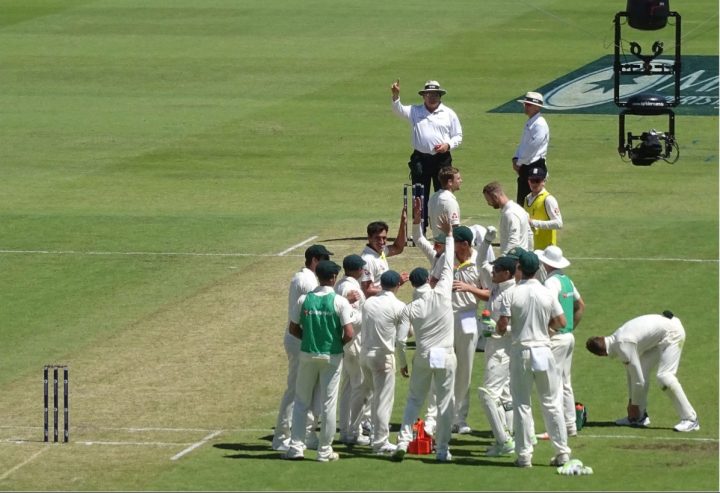
We don’t believe in kicking a team when they’re down (unless they’re Australia) so we hate to go on about his. However the fact remains that most of this series has been so one-sided that it hasn’t really felt like test cricket.
Sometimes when India have been in the field, it has felt more like a county second XI fixture, in which first team batsmen returning from injury have filled their boots against a bunch of teenagers – most of which stand a snowball’s chance in hell of earning a professional contract.
However, yesterday was different. It felt like an intense, competitive, quality contest between bat and ball. The reason? India finally showed some fight, and England’s bowlers had to work hard for their wickets.
Of course, the man that made yesterday’s play so good was Rahul Dravid. Many people call him ‘the wall’, but we don’t think that does him justice. Walls erode over time, get covered in moss, and local councils fail to repair them when they fall down.
Dravid is more like an impregnable fortress built on top of a mountain. Breaching his defences seems impossible. Imagine how many he’d score against India’s attack if he does this to England?!
During the Ashes, Mike Hussey proved equally tough to dislodge. He became a right pain in the posterior. By the fifth test, the mere sight of him became more irritating than a Ukrainian Eurovision song contest entry.
However, I doubt anyone feels that way about Dravid. The man oozes class from every pore. His 146no in India’s first innings was only the third time an Indian batsman has carried his bat. It was an education in disciplined batting; when England finally dismissed him in the second innings, it seemed a bit unreal.
Dravid’s dismissal was actually another reason why yesterday was so good. Everyone likes a bit of controversy. It was one of those bat-pad decisions that could have gone either way. Ross Tucker initially gave it not out, but England were convinced they had their man.
The DRS was hindered by the fact that Ian Bell, fielding at short-leg, rendered the side-on hotspot camera useless – Bell’s leg was in the way at the precise moment that the ball passed the outside of Dravid’s bat.
As a result, Steve Davis was restricted to the front-on hotspot camera, which was never going to show up a thin edge, and ordinary slow motion replays. Davis obviously thought he saw a deflection when the ball passed the bat – but opinion was divided. The Sky commentators were split down the middle.
When Dravid was given out, the Indian TV channels, Twitter, and the blogosphere went into meltdown. Obviously the majority of our Indian friends felt that Davis didn’t have enough evidence to overrule the on-field decision, and once again the DRS had failed – and therefore their intransigent refusal to accept technology was justified.
Once again, these people were totally wrong. The Indian attitude seems to be: ‘if the DRS isn’t perfect then it’s useless and it shouldn’t be used’. Despite this, however, they’re quite happy to use the human eye, which is even more fallible.
The Indians argument just doesn’t make sense. I imagine they weren’t so incensed earlier in the day when the on-field umpire gave Dravid out – an absolutely shocking decision – and the DRS promptly overruled the decision and reinstated India’s linchpin.
The argument that Davis didn’t have enough evidence to overrule the decision has some validity – but those who use this to condemn DRS entirely are missing the point. Davis obviously thought that he did have enough evidence. That was his opinion – and cricket is a game of opinions. Close calls are rarely clear cut.
The problem, of course, is that the Indians are simply asking too much of the DRS. It isn’t perfect, but it does help us to get more decisions right by eliminating the howlers. Therefore it’s invaluable. Besides, Dravid has since admitted that he nicked it – so the right decision was made.
Indian fans need to realise that umpiring decisions will always be somewhat open to subjective interpretation. It’s that way with on-field umpiring – and it’s also the case with third umpire referrals for run-outs and stumpings.
Take the Raina dismissal at the end of day three: it was a close call that could have gone either way. Atherton thought the batsman had a millimetre of his foot behind the line, whereas Manjrekar thought his boot was on the line. The third umpire agreed with Manjrekar and Raina was on his way. Nobody complained then. Why should the DRS be judged by harsher standards than ordinary third umpire referrals?
My conclusion is this really: if you’re in favour of using the third umpire for runs outs and stumpings, then you should also be in favour of the DRS. They’re effectively the same thing.
I can understand it when people oppose technology because they believe that human error is part of the game, and that constant referrals interrupt the flow of the game, but otherwise critics of the DRS should get real.
James Morgan









Yesterday was test cricket par excellence. The contest between Swann and the Indian batsmen during the final session was one of the most absorbing passages of play I’ve seen for a long time. In an odd sort of way, Swann was actually spinning the ball too much – where’s Gareth Batty when we need him???
I felt sorry for poor old Aggers last night. Dozens of Indian headbangers had descended on his Twitter feed complaining about how the Dravid dismissal was further evidence of an English conspiracy to humiliate brave India this summer.
Can I ask a question?
Raina’s LBW dismissal was shown to be unfortunate since he had nicked it onto his pads. However, it appears to me that the ball was in fact caught in the slips so he was out anyways. My question is – if there HAD been DRS in play for LBW and this decision had been reviewed and overturned, then would the catch situation have had any relevance?
Perry Mitchell
I’m pretty sure the ball bounced before it reached the fielder, but I might be wrong. If it had gone to DRS, the off-field umpire would have informed his on-field colleagues of the catch and the batsman would have been given out.
The Indians have got it all wrong basically. If it wasn’t for television who would have seen Richie O’Grommit in his pomp in 1908? We’ve Rupert Murdoch to thank for that. Without technology there would be no super soppers. We’d have to use sponges. Then where would we be? We might as well have let Napoleon win. At the end of the day, you can’t hold back the tide.